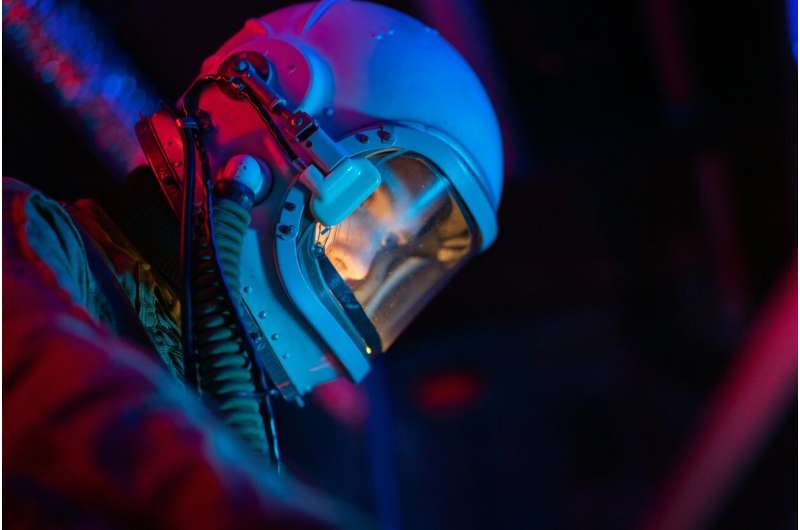This article has been reviewed according to Science X's editorial process and policies. Editors have highlighted the following attributes while ensuring the content's credibility:
fact-checked
peer-reviewed publication
trusted source
proofread
Would astronauts' kidneys survive a roundtrip to Mars?

The structure and function of the kidneys is altered by space flight, with galactic radiation causing permanent damage that would jeopardize any mission to Mars, according to a new study led by researchers from UCL.
The study, published in Nature Communications, is the largest analysis of kidney health in space flight to date and includes the first health dataset for commercial astronauts. It is published as part of a Nature special collection of papers on space and health.
Researchers have known that space flight causes certain health issues since the 1970s, in the years after humans first traveled beyond Earth's magnetic field, most famously during the first moon landing in 1969. These issues include loss of bone mass, weakening of the heart and eyesight, and development of kidney stones.
It is thought that many of these issues stem from exposure to space radiation, such as solar winds from the sun and Galactic Cosmic Radiation (GCR) from deep space, which the Earth's magnetic field protects us from on Earth. As most manned space flights take place in Low Earth orbit (LEO) and receive partial protection from Earth's magnetic field, only the 24 people who have traveled to the moon have been exposed to unmitigated GCR and only for a short time (six to 12 days).
Nobody has studied what changes might be happening in the kidneys and other organs as a result of conditions that would be experienced during space travel beyond Earth's magnetic field over longer periods.
In this study, a UCL-led team of researchers from over 40 institutions across five continents conducted a range of experiments and analyses to investigate how the kidneys respond to space flight.
This included biomolecular, physiological and anatomical assessments using data and samples from 20 study cohorts. This included samples from over 40 Low Earth orbit space missions involving humans and mice, most of which were to the International Space Station, as well as 11 space simulations involving mice and rats.
Seven of these simulations involved mice exposed to simulated GCR doses equivalent to 1.5-year and 2.5-year Mars Missions, mimicking space flight beyond Earth's magnetic field.
The results indicated that both human and animal kidneys are 'remodeled' by the conditions in space, with specific kidney tubules responsible for fine tuning calcium and salt balance showing signs of shrinkage after less than a month in space. Researchers say the likely cause of this is microgravity rather than GCR, though further research is required to determine if the interaction of microgravity and GCR can accelerate or worsen these structural changes.
The primary reason that kidney stones develop during space missions had previously been assumed to be solely due to microgravity-induced bone loss that leads to a build-up of calcium in the urine. Rather, the UCL team's findings indicated that the way the kidneys process salts is fundamentally altered by space flight and likely a primary contributor to kidney stone formation.
Perhaps the most alarming finding, at least for any astronaut considering a three-year round trip to Mars, is that the kidneys of mice exposed to radiation simulating GCR for 2.5 years experienced permanent damage and loss of function.
Dr. Keith Siew, first author of the study from the London Tubular Center, based at the UCL Department of Renal Medicine, said, "We know what has happened to astronauts on the relatively short space missions conducted so far, in terms of an increase in health issues such as kidney stones. What we don't know is why these issues occur, nor what is going to happen to astronauts on longer flights such as the proposed mission to Mars.
"If we don't develop new ways to protect the kidneys, I'd say that while an astronaut could make it to Mars they might need dialysis on the way back. We know that the kidneys are late to show signs of radiation damage; by the time this becomes apparent it's probably too late to prevent failure, which would be catastrophic for the mission's chances of success."
The authors say that though the results identify serious obstacles to a Mars mission, it is necessary to identify problems before solutions can be developed.
Professor Stephen B. Walsh, senior author of the study from the London Tubular Center, UCL Department of Renal Medicine, said, "Our study highlights the fact that if you're planning a space mission, kidneys really matter. You can't protect them from galactic radiation using shielding, but as we learn more about renal biology it may be possible to develop technological or pharmaceutical measures to facilitate extended space travel.
"Any drugs developed for astronauts may also be beneficial here on Earth, for example by enabling cancer patients' kidneys to tolerate higher doses of radiotherapy, the kidneys being one of the limiting factors in this regard."
Though the study only describes what happens to the kidneys up to two and a half years, it is the most comprehensive data available for the time being.
More information: Keith Siew et al, Cosmic Kidney Disease: An integrated panomic, physiological and morphological study into spaceflight-induced renal dysfunction', Nature Communications (2024). DOI: 10.1038/s41467-024-49212-1
Journal information: Nature Communications , Nature
Provided by University College London



















